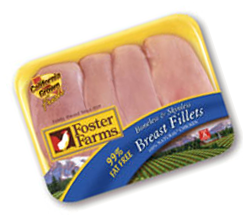In Feb., 2014, Melvin N. Kramer,
president
of EHA Consulting Group, wrote a piece about the ongoing Salmonella outbreak linked to Foster Farms poultry.
It is reprinted here with permission.
The CDC reported that as “of January 15, 2014, a total of 430 persons infected with seven outbreak strains of Salmonella Heidelberg have been reported from 23 states and Puerto Rico.” (1) In response to the news, the popular media, the technical and professional public health and consumer publications, including the blogosphere, have weighed in with opinions.
 The question is whether or not the poultry producer should have voluntary recalled the raw chicken, which based on epidemiologic, laboratory, and traceback investigations conducted by local, state, and federal officials, indicated “that consumption of Foster Farms brand chicken is the likely source of this outbreak of Salmonella Heidelberg infections.”(2) This question is not only multi-faceted, but has a rich history, both from a public health, public policy, and legal perspective dating back to the early 1970s.
The question is whether or not the poultry producer should have voluntary recalled the raw chicken, which based on epidemiologic, laboratory, and traceback investigations conducted by local, state, and federal officials, indicated “that consumption of Foster Farms brand chicken is the likely source of this outbreak of Salmonella Heidelberg infections.”(2) This question is not only multi-faceted, but has a rich history, both from a public health, public policy, and legal perspective dating back to the early 1970s.
I feel in a somewhat unique position to write this paper since my superior at the New Jersey State Department of Health, Oscar J. Sussman, DVM, JD, MPH was involved. He influenced the American Public Health Association (APHA) to formally sue the United States Department of Agriculture for failure to warn the public that up to 50.8% of Federally Inspected poultry was positive for salmonella.(3) Sussman wanted the USDA to put a very simplistic warning on every retail package of poultry stating, “Caution. Improper cooking of this product may be hazardous to your health.”(4)
The warning was to counter the seal of inspection in which the USDA certifies that the poultry is “wholesome” because a pathogen such as salmonella is not wholesome unless and until the poultry is properly thermalized to an internal temperature of 165°F. This temperature will adequately kill all salmonella and other pathogens present.
The lawsuit was filed and adjudicated in the United States District Court for the District of Columbia. The issue of the litigation went in a slightly different direction challenging the Wholesome Meat Act and the Wholesome Poultry Products Act as contained in 21 U.S.C.S. § 601, et seq. and 21 U.S.C.S. § 41 et seq., respectively.
In the initial case, which was ultimately appealed and decided on December 19, 1974 by the United State Court of Appeals for the District of Columbia Circuit in the matter styled APHA v. Butz, the plaintiffs argued that the government’s official mark of inspection was misleading; therefore, the product was misbranded since the USDA failed to warn against the dangers of salmonella.(5)
 Although the USDA tried to settle the case in exchange for consumer education, which they ultimately did, the case went on to the appellate court, which affirmed the lower trial court’s decision in favor of the government.(6)
Although the USDA tried to settle the case in exchange for consumer education, which they ultimately did, the case went on to the appellate court, which affirmed the lower trial court’s decision in favor of the government.(6)
What is relevant to the current debate with Foster Farms boils down to the definition of the term “adulterated”, defined in the statute as:
(1) if it bears or contains any poisonous or deleterious substance which may render it injurious to health; but in case the substance is not an added substance, such article shall not be considered adulterated under this clause if the quantity of such substance in or on such article does not ordinarily render it injurious to health.(7)
The USDA’s position, which was the prevailing position per the lawsuit decision, was articulated in a letter from the USDA on August 18, 1971 and cited in the appellate opinion, which stated:
“the ‘American consumer knows that raw meat and poultry are not sterile and, if handled improperly, perhaps could cause illness’ In other words, American housewives and cooks normally are not ignorant or stupid and their methods of preparing and cooking of food do not ordinarily result in salmonellosis.”(8)
The Court’s opinion that salmonella in raw poultry is not an adulterant is the reason why Foster Farms did not conduct a voluntary recall nor was there a withdrawal of the USDA from the plant, which would in effect close the processing facility. Furthermore, the plant must be operating within the numerous USDA regulations or else there would have been significant negative consequences up to and including the withdrawal of inspection.
In contrast to the poultry producer, Costco’s El Camino Real store in South San Francisco, Calif., voluntarily recalled 9,043 units (approximately 39,755 lbs.) of rotisserie chicken products that may be contaminated with a strain of Salmonella Heidelberg, according to the U.S. Department of Agriculture’s Food Safety and Inspection Service (FSIS).
 Costco recalled 8,730 “Kirkland Signature Foster Farms” rotisserie chickens and 313 total units of “Kirkland Farm” rotisserie chicken soup, rotisserie chicken leg quarters, and rotisserie chicken salad. The products were sold directly to consumers in a Costco located at 1600 El Camino Real, South San Francisco, Calif., between Sept. 11 and Sep. 23, 2013.(9) The initial recall was initiated on Oct. 12, 2013 due to concerns about a group of Salmonella Heidelberg illnesses that may be associated with the consumption of rotisserie chicken products prepared in and purchased at the Costco El Camino Real store.
Costco recalled 8,730 “Kirkland Signature Foster Farms” rotisserie chickens and 313 total units of “Kirkland Farm” rotisserie chicken soup, rotisserie chicken leg quarters, and rotisserie chicken salad. The products were sold directly to consumers in a Costco located at 1600 El Camino Real, South San Francisco, Calif., between Sept. 11 and Sep. 23, 2013.(9) The initial recall was initiated on Oct. 12, 2013 due to concerns about a group of Salmonella Heidelberg illnesses that may be associated with the consumption of rotisserie chicken products prepared in and purchased at the Costco El Camino Real store.
On October 17, 2013 Costco’s El Camino Real store in San Francisco, Calif., voluntarily recalled an additional 14,093 units of rotisserie chicken products that may be contaminated with a strain of Salmonella, the U.S. Department of Agriculture’s Food Safety and Inspection Service (FSIS) announced. This is in addition to the 9,043 units that were recalled on Oct. 12.
The products subject to recall were 13,455 “Kirkland Signature Foster Farms” rotisserie chickens and 638 total units of “Kirkland Farm” rotisserie chicken soup, rotisserie chicken leg quarters, and rotisserie chicken salad. The products were sold directly to consumers in a Costco located at 1600 El Camino Real, South San Francisco, Calif., between Sept. 24 and Oct. 15, 2013.(10) These recalls were appropriate and in the best interest of public health, since it was in a ready-to-eat product, which all consumers have a right to expect is pathogen free.
Conversely, Tyson Foods, Inc. a Sedalia, Mo., establishment, voluntarily recalled approximately 33,840 pounds of mechanically separated (raw) chicken products that may be contaminated with a Salmonella Heidelberg strain, the U.S. Department of Agriculture’s Food Safety and Inspection Service (FSIS) announced today (January 10, 2014).
The mechanically separated chicken products were produced on Oct. 11, 2013. The following products are subject to recall: 40-lb. cases, containing four, 10-lb. chubs of “TYSON MECHANICALLY SEPARATED CHICKEN.””(11) This product was not available to the consumer, and in fact, was for institutional customers (this was from a correctional facility).
Salmonella’s status as a possible adulterant has been litigated, resulting in courts not considered salmonella an adulterant. From a public health law perspective, unless Congress passes specific legislation and signed into law by the President naming salmonella as an adulterant, raw poultry with salmonella will continue to not be considered an adulterated and, therefore, not subject to involuntary or mandatory recall or plant shutdown.
 The public policy facet of this debate I think is more interesting than the recalls themselves. As referenced earlier, the USDA settled the legal case in exchange for consumer education in the early 1970s. At that time, and to an extent to this date, all the USDA offered were public service spots on radio and television, particularly around holidays and other times with heavy consumer consumption of meat and poultry.
The public policy facet of this debate I think is more interesting than the recalls themselves. As referenced earlier, the USDA settled the legal case in exchange for consumer education in the early 1970s. At that time, and to an extent to this date, all the USDA offered were public service spots on radio and television, particularly around holidays and other times with heavy consumer consumption of meat and poultry.
However, the USDA’s FSIS (Food Safety and Inspection Service) also adopted mandatory Safe Handling Instructions (reproduced below), which are described in the Code of Federal Regulations, title 9, parts 317 and 381. In reality, I believe these mandatory Safe Handling Instructions gave credence to Dr. Sussman and the APHA’s position in the litigation. Furthermore, I believe consumer warnings would have potentially prevented untold illness and deaths from raw meat and poultry, if commenced decades earlier.
Safe Handling Instructions
This product was prepared from inspected and passed meat and/or poultry. Some food products may contain bacteria that could cause illness if the product is mishandled or cooked improperly. For your protection, follow these safe handling instructions.
- Keep refrigerated or frozen. Thaw in refrigerator or microwave.
- Keep raw meat and poultry separate from other foods. Wash working surfaces (including cutting boards), utensils, and hands after touching raw meat or poultry.
- Cook thoroughly.
- Keep hot foods hot. Refrigerate leftovers immediately or discard.(12)
The historic problem, and the rationale for the Safe Handling Instructions, is that consumers lacked appropriate handwashing practices and strategies to prevent cross-contamination between raw poultry and ready-to-eat foods as well as lacked adequate and verifiable thermalization of poultry to ensure thermal kill of salmonella and any other pathogens.
Therefore, the American consumer – whether in their kitchen or in a ready-to-eat processing plant, an institution such as a healthcare facility or university or retail food establishment – must pay acute attention to handwashing, not cross-contaminating raw and ready to eat food products, and thermalization of poultry to 165°F, verified with a calibrated thermometer.
 Although it would be ideal to have a guarantee that no pathogens would be present on raw poultry, or for that matter raw beef, seafood, shellfish, fruits, and vegetables, it is not a reality. Eradicating pathogens from raw food is likely not possible without getting into another thorny issue, which is irradiation of food.
Although it would be ideal to have a guarantee that no pathogens would be present on raw poultry, or for that matter raw beef, seafood, shellfish, fruits, and vegetables, it is not a reality. Eradicating pathogens from raw food is likely not possible without getting into another thorny issue, which is irradiation of food.
If poultry was irradiated, there would be no salmonella in raw poultry! However, until the government passes law otherwise, it is incumbent on consumers to be vigilant and take precautions to ensure pathogen prevention.
(1) http://www.cdc.gov/salmonella/heidelberg-10-13/index.html
(2) Id.
(3) The exact statistic has varied in numerous studies as described in a June 30, 1966 article in the New England Journal of Medicine entitled Isolation of Salmonella from Poultry. Arthur Wilder. Isolation of Salmonella from Poultry. The New England of Journal of Medicine. Volume 274, Number 26. June 30, 1966.
(4) Claim USDA Meat Inspection Inadequate. AP Release. November 6, 1971.
(5) American Public Health Asso. v. Butz. 511 F.2d 331 U.S. App. (1974).
(6) Id.
(7) 21 U.S.C.S § 601
(8) 511 F.2d 334 (1974)
(9) http://www.fsis.usda.gov/wps/portal/fsis/topics/recalls-and-public-health-alerts/recall-case-archive/archive/2013/recall-058-2013-release
(10) http://www.fsis.usda.gov/wps/portal/fsis/topics/recalls-and-public-health-alerts/recall-case-archive/archive/2013/recall-058-2013-expanded
(11) http://www.fsis.usda.gov/wps/portal/fsis/topics/recalls-and-public-health-alerts/recall-case-archive/archive/2014/recall-001-2014-release
(12) http://www.fsis.usda.gov/wps/portal/fsis/topics/food-safety-education/teach-others/download-materials/image-libraries/safe-handling-label-text/ct_index
 Most recent 10-week data shared with the U.S. Department of Agriculture showed that salmonella levels in the firm’s chicken parts had dropped to 2 percent — far below the industry benchmark of 25 percent, Foster Farms officials said.
Most recent 10-week data shared with the U.S. Department of Agriculture showed that salmonella levels in the firm’s chicken parts had dropped to 2 percent — far below the industry benchmark of 25 percent, Foster Farms officials said.














